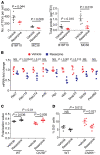Regulation of intercellular biomolecule transfer-driven tumor angiogenesis and responses to anticancer therapies
- PMID: 33998600
- PMCID: PMC8121529
- DOI: 10.1172/JCI144225
Regulation of intercellular biomolecule transfer-driven tumor angiogenesis and responses to anticancer therapies
Abstract
Intercellular biomolecule transfer (ICBT) between malignant and benign cells is a major driver of tumor growth, resistance to anticancer therapies, and therapy-triggered metastatic disease. Here we characterized cholesterol 25-hydroxylase (CH25H) as a key genetic suppressor of ICBT between malignant and endothelial cells (ECs) and of ICBT-driven angiopoietin-2-dependent activation of ECs, stimulation of intratumoral angiogenesis, and tumor growth. Human CH25H was downregulated in the ECs from patients with colorectal cancer and the low levels of stromal CH25H were associated with a poor disease outcome. Knockout of endothelial CH25H stimulated angiogenesis and tumor growth in mice. Pharmacologic inhibition of ICBT by reserpine compensated for CH25H loss, elicited angiostatic effects (alone or combined with sunitinib), augmented the therapeutic effect of radio-/chemotherapy, and prevented metastatic disease induced by these regimens. We propose inhibiting ICBT to improve the overall efficacy of anticancer therapies and limit their prometastatic side effects.
Keywords: Colorectal cancer; Endothelial cells; Oncology; Vascular Biology.
Conflict of interest statement
Figures









Similar articles
-
An Interferon-Driven Oxysterol-Based Defense against Tumor-Derived Extracellular Vesicles.Cancer Cell. 2019 Jan 14;35(1):33-45.e6. doi: 10.1016/j.ccell.2018.12.001. Cancer Cell. 2019. PMID: 30645975 Free PMC article.
-
Sox17 promotes tumor angiogenesis and destabilizes tumor vessels in mice.J Clin Invest. 2013 Jan;123(1):418-31. doi: 10.1172/JCI64547. Epub 2012 Dec 17. J Clin Invest. 2013. PMID: 23241958 Free PMC article. Clinical Trial.
-
Loss of apelin blocks the emergence of sprouting angiogenesis in experimental tumors.FASEB J. 2022 Oct;36(10):e22560. doi: 10.1096/fj.202200616RR. FASEB J. 2022. PMID: 36165236
-
Consequences of angiogenesis for tumor progression, metastasis and cancer therapy.Anticancer Drugs. 1995 Feb;6(1):3-18. doi: 10.1097/00001813-199502000-00001. Anticancer Drugs. 1995. PMID: 7538829 Review.
-
Pericytes and vessel maturation during tumor angiogenesis and metastasis.Am J Hematol. 2010 Aug;85(8):593-8. doi: 10.1002/ajh.21745. Am J Hematol. 2010. PMID: 20540157 Review.
Cited by
-
NUPR1 packaged in extracellular vesicles promotes murine triple-negative breast cancer in a type 1 interferon-independent manner.Extracell Vesicles Circ Nucl Acids. 2024;5(1):19-36. doi: 10.20517/evcna.2023.59. Epub 2024 Jan 15. Extracell Vesicles Circ Nucl Acids. 2024. PMID: 38405101 Free PMC article.
-
Modified C-type natriuretic peptide normalizes tumor vasculature, reinvigorates antitumor immunity, and improves solid tumor therapies.Sci Transl Med. 2024 Aug 21;16(761):eadn0904. doi: 10.1126/scitranslmed.adn0904. Epub 2024 Aug 21. Sci Transl Med. 2024. PMID: 39167664 Free PMC article.
-
ATF3 and CH25H regulate effector trogocytosis and anti-tumor activities of endogenous and immunotherapeutic cytotoxic T lymphocytes.Cell Metab. 2022 Sep 6;34(9):1342-1358.e7. doi: 10.1016/j.cmet.2022.08.007. Cell Metab. 2022. PMID: 36070682 Free PMC article.
-
Tumor-Suppressive and Immune-Stimulating Roles of Cholesterol 25-hydroxylase in Pancreatic Cancer Cells.Mol Cancer Res. 2023 Mar 1;21(3):228-239. doi: 10.1158/1541-7786.MCR-22-0602. Mol Cancer Res. 2023. PMID: 36378658 Free PMC article.
-
Endothelial cell-derived oxysterol ablation attenuates experimental autoimmune encephalomyelitis.EMBO Rep. 2023 Mar 6;24(3):e55328. doi: 10.15252/embr.202255328. Epub 2023 Jan 30. EMBO Rep. 2023. PMID: 36715148 Free PMC article.
References
Publication types
MeSH terms
Substances
Grants and funding
LinkOut - more resources
Full Text Sources
Other Literature Sources
Molecular Biology Databases
Research Materials

